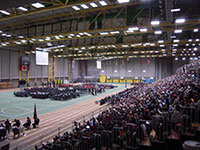view all Case Studies
Self-powered Lighting Controls Correct Design Oversight

Several months into the design and development of the Workers Compensation Fund facility in Sandy, Utah, the owner decided to pursue LEED Silver certification. As the core-and-shell package was already underway, designers would have to focus on the interior of the facility to achieve the goal for the non-profit mutual insurance company.
August 22, 2011 -
Lighting
Several months into the design and development of the Workers Compensation Fund facility in Sandy, Utah, the owner decided to pursue LEED Silver certification. As the core-and-shell package was already underway, designers would have to focus on the interior of the facility to achieve the goal for the non-profit mutual insurance company.
One strategy was to provide a zoned area daylight harvesting system in all the open areas of the facility that responds to both daylight in the space and occupancy sensors, and integrates with other building systems. A challenge to the success of this strategy wasn't discovered until after the building was occupied. The HVAC system included disc diffusers, which move a lot of air across the ceiling at high volume. This interfered with the sensing capability of the ultrasonic occupancy sensors.
To overcome this, the ultrasonic devices were removed and replaced with Leviton’s passive infrared occupancy sensors, which are not subject to false triggering from the air movement. To compensate for the difference in coverage areas between the ultrasonic and PIR sensors, LevNet RF products were used, combining the wireless receiver with the necessary number of solar powered wireless PIR devices to provide adequate coverage of each of the spaces. Each receiver can accommodate up to 30 devices.
The receiver was mounted above the ceiling at an existing hardwired PIR location near the center of each lighting zone and used the same power and trigger wiring that existed at the device. The wireless motion sensors were paired with the areas receiver and then located as necessary to provide adequate motion coverage of the space.
The use of wireless devices reduced installation costs and allowed for energy savings from both daylight harvesting and on/off control of the facilities lighting. The facility was awarded LEED Gold status.
Next
Read next on FacilitiesNet












